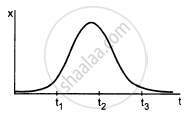Advertisements
Advertisements
Question
Give example of a motion where x > 0, v < 0, a > 0 at a particular instant.
Solution
Let the motion is represented by `x(t) = A + Be^(-γt)` .....(i)
Let A > B and ϒ > 0
Now velocity `x(t) = (dx)/(dt) = - Bγ^(-γt)`
Acceleration `a(t) = (dx)/(dt) = Bγ^2e^(-γt)`
Suppose we are considering any instant t, then from equation (i), we can say that
x(t) > 0; v(t) < 0 and a > 0
APPEARS IN
RELATED QUESTIONS
Read the statement below carefully and state, with reason and example, if it is true or false:
A particle in one-dimensional motion with constant speed must have zero acceleration.
Suggest a suitable physical situation for the following graph:

The given figure gives a speed-time graph of a particle in motion along a constant direction. Three equal intervals of time are shown. In which interval is the average acceleration greatest in magnitude? In which interval is the average speed greatest? Choosing the positive direction as the constant direction of motion, give the signs of v and a in the three intervals. What are the accelerations at the points A, B, C and D?

Give example where the velocity of a particle is zero but its acceleration is not zero.
Give example where the velocity is opposite in direction to the acceleration.
In figure shows the x coordinate of a particle as a function of time. Find the sings of vx and ax at t = t1, t = t2 and t = t3.

A stone is released from an elevator going up with an acceleration a. The acceleration of the stone after the release is
The displacement of particle is given by x = `2/lambda (1 - e^(-lambdat))`, the acceleration of particle at 2s when λ = 2s–1 will be (Take `l`n 0.018 = – 4)
A lift is coming from 8th floor and is just about to reach 4th floor. Taking ground floor as origin and positive direction upwards for all quantities, which one of the following is correct?
An object falling through a fluid is observed to have acceleration given by a = g – bv where g = gravitational acceleration and b is constant. After a long time of release, it is observed to fall with constant speed. What must be the value of constant speed?
